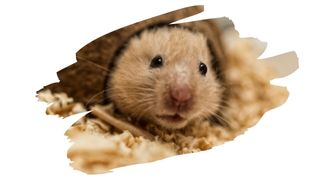Chipboard (also known as Particle Board) is an affordable alternative to using natural solid wood. Which is why this low-cost engineered wood is used to make budget-saving furniture, such as desks and cabinets.
However, as the saying goes, you get what you pay for. And when a material is as cheap as chips(board), there’s usually a price paid somewhere else.
And that price comes in the form of some nasty chemicals lurking inside the glue of this manufactured wood.
Now, usually, those chemicals aren’t a problem you need to worry about, provided that Chipboard is sealed.
So, in this post you will find out what really goes into the manufacture of Chipboard. You will also learn what ‘off-gassing’ is — and why it can pose a danger to your hamster’s safety.
And keep reading to discover why the only wood you should use for your hamster’s home is natural solid wood.

This post may contain affiliate links to products that we receive a commission for (at no additional cost to you). Learn more here.
What Is Chipboard Actually Made From?
Chipboard is an engineered material. In other words, while it does contain wood chips, it also contains a lot of manufactured substances; namely, glue.
Chemical glues are used to hold those wood chips together, keeping them bound.
And What Kind Of Chemicals Are We Talking About Here?
Well, that is where things get interesting (or worrying, depending on how you look at it).
The glues used inside Chipboard contain formaldehyde resins. Namely, they can contain Urea-formaldehyde, Melamine-formaldehyde, or sometimes Phenol-formaldehyde, in them.
And those formaldehyde resins make freshly manufactured Chipboard dangerous to be around.
Formaldehyde is so toxic, it can poison you if you ingest it. And if it gets on your skin, it can burn you.
However, it is at its most lethal as a vapor. If inhaled, this substance can burn your nose and throat.
Is Chipboard More Dangerous Than Other Manufactured Woods?
It depends on what type of manufactured wood you’re comparing it against.
Compared to Plywood, Chipboard is more dangerous.
Plywood also often contains formaldehyde-resin glues in it. However, because Chipboard is more dense than plywood, Chipboard contains more glue.
And this leads to Chipboard containing greater amounts of formaldehyde resin (compared to plywood).
Related Post: Is Plywood A Safe Material For A Hamsters Cage?
Nonetheless, Chipboard (also known as Low Density Fiberboard), isn’t the most densely packed manufactured wood out there.
MDF (Medium Density Fiberboard) also contains wood by-product and formaldehyde-based glues too.
Except MDF is more densely packed than Chipboard. So, MDF often contains larger amounts of formaldehyde-based glues in it than Chipboard.
If Chipboard Contains Formaldehyde, Is It Dangerous To Work With?
Only if it is still off-gassing. Off-gassing refers to the fumes that drift off solvents and glues as they dry.
As these solvents/glues dry, they release VOCs (Volatile Organic Compounds) into the air. And you can sometimes smell those VOCs when a fresh coat of paint is drying.
However, what you may not know is that long after paints/solvents/glues dry, they can continue to off-gas. And, when it comes to formaldehyde-based glues, this can be dangerous.
In the case of formaldehyde-based glues, they can off-gas fumes for up to two years after manufacture.
Nevertheless, before you purchase Chipboard, the manufacturer/shop will have given Chipboard plenty of time to dry out.
So, by the time you purchase it — provided you properly seal it — Chipboard is safe to have in your home.
So Should I Be Worried About Using Chipboard Around My Hamster?
Yes you should, but not because of formaldehyde vapor.
Regardless of whether Chipboard has been sealed, you should be concerned about using it around chew-happy pets.
If your hamster chews through that sealed chipboard, they will end up ingesting the chemical glues inside this material. And those glues are anything but safe for hamsters to consume.
This is why you should not use manufactured woods, (such as MDF or Chipboard), around animals that like to chew wood. And hamsters are no exception.
Related Post: Is MDF Safe To Use For Your Hamsters Home?
Does That Mean Chipboard Is Not Safe For Hamsters?
No, it is not, not at all.
Your pet hamster may chew into that Chipboard material. And their bites are strong enough to chew through most any Chipboard sealant.
So, err on the side of caution. Avoid chipboard altogether and keep it well away from your hamster.
So What Type Of Wood Is Safe For Hamsters?
The only safe type of wood is solid natural wood. And that wood should be untreated, kiln-dried, and free of any wood sealers or chemical treatments.
What’s more, only use wood that is safe for hamsters to chew into, such as Apple wood.
Related Post: Want To Use Apple Wood For Woodworking? 3 Things To Know
Also, it’s worth pointing out here that you should avoid using any lumber that contains lots of tree sap/pitch.
Tree sap is a natural resinous substance that trees secrete. However, it is not safe for your hamster to ingest.
So wood types, such as fir and Pine, should be avoided as well. They are saturated with sap, so try to steer clear of them.
Got It. But One More Thing… What Is Kiln Dried Wood Exactly?
Kiln dried wood refers to wood that has been seasoned using a special heat treatment. This is done by slow-baking wood in a kiln oven.
Typically, wood seasoning can take up to a year if you leave freshly logged lumber to air dry. Except kiln-drying wood cuts that waiting time down to a matter of days.
Related Post: How To Season Wood (7 Tips)
Now, the great thing about kiln drying is that it’s great at getting rid of any hidden bugs living inside wood.
And it is the perfect way to dry out excess tree sap too. That’s because that high heat will evaporate sap away.
If you want to learn more, check out our post: Kiln Dried Vs Air Dried Wood: Which Type Of Seasoned Lumber Is Right For Your Furniture?
To Sum Up, Here Are The 3 Key Things You Need To Know From This Post…
- 1). Chipboard is an engineered wood that contains wood chips and chemical glues.
- 2). The chemical glues often used inside Chipboard contain formaldehyde resin. This makes Chipboard unsafe to use around animals that are likely to chew into this material.
- 3). Only use natural solid kiln-dried wood in your hamster’s home. That wood should come from a hamster-safe wood species, and it should not be chemically treated or sealed.
References:
Creating the right home for your hamster | RSPCA.org.uk
Pędzik M, Auriga R, Kristak L, Antov P, Rogoziński T. Physical and Mechanical Properties of Particleboard Produced with Addition of Walnut (Juglans regia L.) Wood Residues. Materials (Basel). 2022 Feb 9;15(4):1280. doi: 10.3390/ma15041280. PMID: 35207821; PMCID: PMC8880566.



